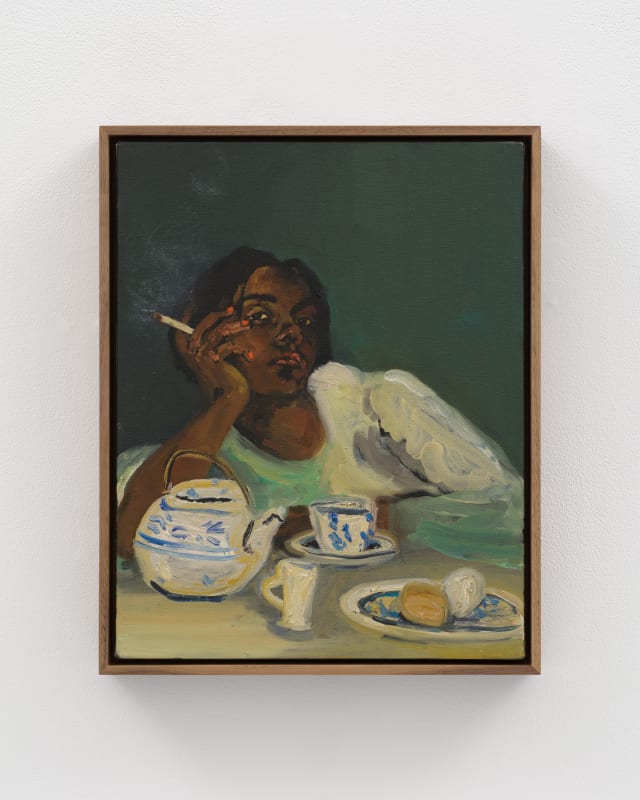BY CHARLES MOORE
Throughout this spring and summer, the Fondazione Sandretto Re Rebaudengo is presenting Fly on the Wall, the first Italian solo exhibition of American portrait artist Danielle McKinney (b. 1981 in Montgomery, Alabama). The show features a series of new paintings crafted specifically for the Turin arts nonprofit, alongside a selection of curated recent works that unveil Black female subjects in the private comfort of home. In the exhibition, McKinney plays on the metaphor “fly on the wall,” or the act of observing a situation—or person—unnoticed. In her paintings, she bears witness to her subjects in their most authentic moments, depicting what might otherwise only occur behind closed doors.
McKinney’s oil paintings are cinematic, set in ethereal domestic interiors, with each one resembling a film still. The works feature female subjects napping on unmade beds, sprawled out on well-loved sofas, and reading books or smoking cigarettes. Trained as a photographer, the New Jersey-based artist creates works that leverage photographic elements—depicting real-life situations, building environments that amplify the richness of women’s lives during times of stillness. Often, the artist finds inspiration in images found online, in magazines, or in other paintings; throughout, McKinney plays with shapes and gestures, crafting compositions which, after applying a gentle touch, unveil situations that are entirely her own. With plays on shapes and colors, she tells stories that bring her subjects to life, establishing unique interiors, and subsequently developing well-rounded, compelling characters.
Easy Over (2023) showcases a young Black woman seated at a table behind a blue-and-white teacup, a matching kettle steaming on the surface before her alongside a plate of pastries and a small receptacle of cream. She smokes a cigarette, nails painted red, the heel of her hand gently caressing her chin while she gazes at the viewer apathetically; it’s like she’s daring the audience to engage with her. This moment of leisure exudes a sense of calm, the subject leaning over in repose, elbows resting on the table, dressed in a long-sleeved green and white blouse that resembles a cloud. She’s alone and appears entirely at peace, seated in a dark room, the green wall behind her nearly overpowering with its calming effect. Onlookers may be curious about what she thinks and feels; they may wonder who she’s waiting for, what she cares about, and what else she does in her most private moments. The speculation lingers the longer one looks at the canvas. Eventide (2024) is equally captivating: the work reveals another young Black female reclining on a velvety brown couch, resting her left elbow on its arm, her legs bent at the knees. Her position is one we’ve all inhabited, but only in the comfort of home, and almost always in solitude. Here again, the subject smokes a cigarette, finger and toenails painted red; the wall behind her is painted a soothing checkered brown, the floor below a stunning hardwood, planked and bathed in gentle light. The woman’s eyes are closed; she is dressed in elegant cream paired with a blue feathered boa. One can deduce that she’s either contemplating a reluctant evening out or she’s just returned from one. She has immersed herself in the quiet room before her. The figure appears entirely at ease in this moment of solitude; she meditates as the world outside of her immediate vicinity melts away, and McKinney is nothing but a fly on the wall.
Dark rooms adorned with minor bursts of color, a stark contrast between light and shadow not unlike what observers have seen in Johannes Vermeer’s seventeenth-century paintings—McKinney simultaneously casts each work with an Edward Hopperesque sense of introspection. The artist’s subjects seem unaware that they’re being observed, yet her presence is apparent in each scene; it’s as though she protects these women with her gaze, providing a sense of security as she weaves narratives that allow them to inhabit their most vulnerable moments. The oil-on-linen Sandman (2023) emanates this same freedom. In the work, Picasso’s La Rêve (The Dream) (1932) embellishes a dark wall above a young woman napping on her stomach, body splayed across an olive-green couch, a sweeping bouquet of yellow flowers covering her backside while she uses her arms and hands as pillows, a lone leg bent at the knee, red-painted toenails decorating a foot facing the ceiling. Spectators, like the artist, may feel protective of this figure in her vulnerability; though her surroundings are opulent, her existence is one with which we can all relate. There’s comfort in that mundanity, paired with hope and opulence in the subject’s domestic space. McKinney's Sandman, not unlike Picasso's La Rêve, evokes a dream-like introspection, suggesting layers of subconscious exploration. Often portrayed in folklore as a bringer of dreams, the Sandman accentuates this theme by infusing the scene with a sense of ethereal mystery and introspection. This connection not only closes the physical gap between observer and subject but also invites a reflective look at one's own inner landscapes.


